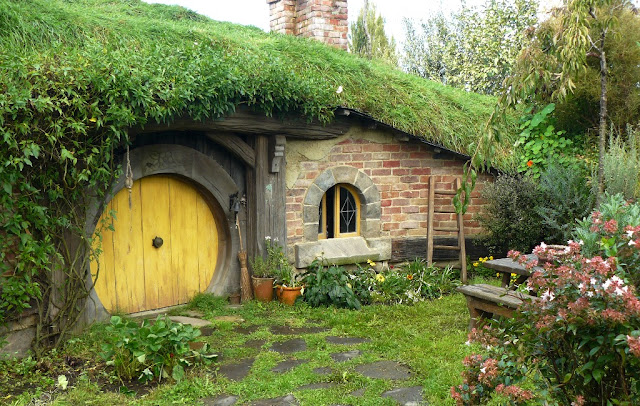 |
| Bag end, home of Bilbo and Frodo (with nasturtium and comfrey) |
It may be unpatriotic to admit this, but I am not a fan of the Lord of the Rings, or Hobbit, films. I enjoyed reading the Hobbit as a child but found Tolkien's LoTR to be a slog. I have watched all the films, to see what the fuss is about, but had trouble staying awake through them. My favourite bits were always in the Hobbit home village.
 |
| Child size chair and a stack of firewood |
I do feel a connection with the stay-at-home hobbits that Frodo and Bilbo left behind, with their cosy underground houses, well-stocked pantries and second breakfasts. So when my cousin from America, who is a serious LoTR film fan, came to Hamilton last week I was happy to have an excuse to visit the nearby film set of Hobbiton, now a Waikato tourist attraction.
 |
| Community garden with birdhouse |
I was quite charmed by Hobbiton, not so much by the round doors, but by the consistent attention to quaint detail. It feels like a cross between an historical village and a permaculture farm, all scaled down to child size. Hobbit extras were required to be 5 foot tall, just my height, so being on their the film set was a rare experience of not feeling too short for the world. Even the furniture and tools were to my scale, with practical little ladders scattered everywhere. It was also a welcome oasis of lush green abundance after a long drought.
 |
| Little ladders come in handy for hobbit-sized folk |
There are no obvious anachronisms once the bus drops you off at the entrance to Hobbiton. In this version of Tolkien's pre-industrial arcadia everything is made by hand of natural materials (or appears to be); from the thatched roofs, fancy iron work, carved wooden facades, lead-light windows to the lush green turf and pretty pumpkins piled around.
 |
| Punpkins in the Green Dragon |
 |
| Hobbit hole facade with doorstep cottage garden |
The original temporary film set has been rebuilt in permanent materials for the popular tourist attraction, now more than 10 years old and entertaining thousands of people every day (70 people every 15-30 minutes all day long every day of the year). It is all make believe, from the empty spaces behind every hobbit hole facade to the painted lichen on the picket fences. Among all the genuine trees in the village there is one (on top of Bag End) which was built from scratch for the first film, at a cost of one million dollars.
 |
| Million dollar fake tree on top of the hill, real trees in the foreground: pear grafted onto quince and apple both laden with unpicked fruit |
I was especially delighted and inspired by the gardens which (the guide advised) are kept looking in just this state of tidy fecundity year round by a team of 30 gardeners, who must finish their work before the first visitors arrive at 9am every morning. The gardens in front of the hobbit holes are refreshed with flats, troughs and pots of plants, changed out regularly for year round blooms. Yet this seems entirely appropriate, for the containers are all weathered wood or faded pottery so they look like what Hobbits would use.

These tiny cottage gardens (which could be replicated in a tiny balcony or courtyard) are complemented by larger community gardens which really reminded me of favourite permaculture gardens I have known. They look like a pretty jumble of plants in polycultures, with great a diversity of not only edible but beneficial insect attracting flowers. These larger gardens are not renewed with pots and flats, but I could see succession planting evident everywhere. Patches of plants abutted in various stages of growth from seedlings to ready to harvest.
The lush green abundance of the whole set is maintained by more irrigation than anyone in town has been using during this recent drought. It was a welcome rest for eyes seared by my sad dry garden at home. I was also glad my cousins got to see the unique lurid green grass of home that is more usual for the Waikato.
 |
| Hobbit swing |
Fake as it all is, I still got inspiration, or at least aesthetic affirmation, for my own garden design aspirations: all curves, no hard straight smooth lines or surfaces. Lots of edges, lots of bee friendly planting. Flowers, herbs, vegetables and fruit all together filling every niche.
 |
| bee and butterfly sharing pollen |
 |
| Mill with row boat and fishing rod |
We got an hour or so to wander through Hobbiton, either at our own pace or following Aiden, our well informed guide. The tour finished at the Green Dragon pub, across a charming stone arch bridge next to the thatched and half timbered mill with working water wheel. There we supped a free cider served in beautiful hand thrown pottery mugs. Sitting by the (real) fire, we looked out across the mill pond, back to Hobbiton.
 |
| Hobbiton across the mill pond |
The Hobbiton experience is expensive ($70 adult, $10 child) but I think its good value, even for a non-fan like me. I was utterly charmed and delighted at every turn. After an hour and a half I didn't want to leave. My Lord of the Rings-fan cousin was satisfied on even more levels.
 |
| Charmed |








